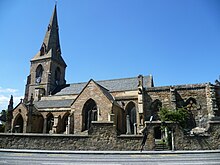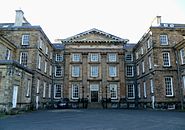| Main | Births etc |
|---|
| Dalkeith | |
| Scottish Gaelic: Dail Cheith | |

|
|
| Population | 12,342 (2011 census) |
|---|---|
| Council area | Midlothian |
| Lieutenancy area | Midlothian |
| Country | Scotland |
| Sovereign state | United Kingdom |
| Post town | DALKEITH |
| Postcode district | EH22 |
| Dialling code | 0131 |
| Police | Lothian and Borders |
| Fire | Lothian and Borders |
| Ambulance | Scottish |
| EU Parliament | Scotland |
| UK Parliament | Midlothian |
| Scottish Parliament | Midlothian North and Musselburgh |
| List of places: UK • Scotland • | |
Dalkeith ( /dælˈkiːθ/ dal-KEETH-'; Scottish Gaelic: Dail Cheith) is a town in Midlothian, Scotland, on the River Esk. It was granted a burgh of barony in 1401 and a burgh of regality in 1540. The settlement of Dalkeith grew southwestwards from its 12th-century castle (now Dalkeith Palace).
Dalkeith has a population of 12,342 people according to the 2011 census.[1]
The town is split into four distinct areas: Dalkeith proper with its town centre and historic core, with Eskbank to its west. and Woodburn to its east. Eskbank is the well-heeled district of Dalkeith with many large Victorian and newer houses. To the south of Eskbank is Newbattle with its abbey. Woodburn is a working class council estate.
Dalkeith is the main administrative centre for Midlothian. It is twinned with Jarnac, France. In 2004, Midlothian Council re-paved Jarnac Court in honour of Dalkeith and Jarnac's long standing link.
There is an estate called Thornybank on the edge of Dalkeith near the industrial estate beyond which is the newly built Dalkeith Campus - housing the high schools of Dalkeith and St David's Roman Catholic High School.
Etymology[]
Dalkeith is understood to be a Cumbric name, cognate with Welsh ddôl 'meadow, plateau, valley' + coed 'wood'.[2]
History[]

Corn Exchange by David Cousin 1853
One of the earliest historical references to Dalkeith is found in the Chronicles of Jean Froissart who stayed at Dalkeith Castle for fifteen days. He writes of the Battle of Otterburn and the death of James Douglas, 2nd Earl of Douglas:
"I, author of this book, in my youth had ridden nigh over all the realm of Scotland, and I was then fifteen days in the house of earl William Douglas, father to the same earl James, of whom I spake of now, in a castle of five leagues from Edinburgh which is called in the country Dalkeith. The same time I saw there this earl James, a fair young child, and a sister of his called the lady Blanche."[3]
In 1650, Oliver Cromwell's army came to Dalkeith. His officer General George Monck, was Commander in Scotland, and the government of the country was based out of Dalkeith castle.[4]
In the 17th century, Dalkeith had one of Scotland's largest markets in its exceptionally broad High Street.
In 1831, Dalkeith was linked to Edinburgh by a railway line that transported coal, minerals, and agricultural produce. Two decades later, in 1853, a Corn Exchange, at the time the largest indoor grain market in Scotland, was built.[5]
In 1879, Dalkeith was where William Ewart Gladstone started his campaign for British Prime Minister, which became known as the "Midlothian Campaign".
Notable buildings[]

St. Nicholas-Buccleuch Church

Tolbooth, Dalkeith
The Collegiate Church of St Nicholas Buccleuch, formerly known as Dalkeith Parish Church, stands on High Street. Dedicated to St Nicholas, this medieval church became a collegiate establishment in 1406, founded by Sir James Douglas. The nave and transepts date from 1854, when the inside of the church was greatly altered. The chancel was abandoned in 1590, walled off from the rest of the church, and is now ruinous. Sir James Douglas, 1st Earl of Morton, and his wife Joanna, daughter of James I, are buried in the choir and have stone effigies. St Nicholas Buccleuch Church remains one of the two Church of Scotland parish churches in Dalkeith, the other being St John's and King's Park Church. The Episcopal Church, St Mary's is on High Street, at the entrance to Dalkeith Country Park.[6] St David's Church, on Eskbank Road, is the only Roman Catholic church in the town, it is a category A listed building and was built in 1854.[7]
Dalkeith Palace which replaced the castle in the late 16th century and was rebuilt in the early 18th century, lies at the north-east edge of the town. It is a seat of the Duke of Buccleuch, surrounded by parkland and follies.
The building on High Street now known as the Tolbooth began to be used as a tolbooth for the administration of the town in the early 18th century. The plaque above the door reads '1648' but this was taken from another building and does not denote when the Tolbooth was built. It served as a place for law and order and featured a prison in the west half, a court room on the east, and a dungeon known as the ‘black hole’ below ground. In front of the building there is a circle of stones to mark the spot where the last public hanging in Dalkeith occurred in 1827.
Other notable buildings include a Watch Tower at the cemetery (1827),[8] a water tower and early 19th century iron mills.
There is a modern Church of Jesus Christ of Latter-day Saints meeting house on Newbattle Road.
Notable people[]
- Robert Aitken (1734–1802), Bible publisher
- Sir John Anderson (later 1st Viscount Waverley) (1882–1958), Home Secretary 1939–1940, Chancellor of the Exchequer 1943–1945
- Edmund Thornton Crawford (1806–1885), artist
- Henry Dundas, 1st Viscount Melville (1742–1811), politician
- Fish (born Derek Dick) (b. 1958), singer with Marillion
- Darren Fletcher (b. 1984), footballer with Manchester United, West Bromwich Albion and Stoke City
- John Kay (1742–1826), artist
- Robert Macpherson (1814–1872), photographer
- David Mushet (1772–1847), pioneer of iron production
- Bob Pringle (1851–1902), professional golfer
- Bobby Smith (1953–2010), footballer with Hibernian and Leicester City
- Robert Smith (1722–1777), American architect
- James Stagg (1900–1975), D-Day meteorologist
- Peter Guthrie Tait (1831–1901), mathematical physicist
Transport[]
Until 2008, Dalkeith was on the A68, one of the main routes south from Edinburgh to Jedburgh and across the border to Darlington. A bypass to take traffic away from the town centre was completed in September, 2008; this then took the A68 number, and the old route of the A68 is now the A6106.[9]
Other main roads serving Dalkeith are:
- A6094 — leads SW towards Bonnyrigg and Peebles, and NE towards Musselburgh
- A768 — leads west from Eskbank to Lasswade and Loanhead
- B6373 — a road wholly within Dalkeith, leaving and rejoining the A6106
- B6414 — leaves the A6094 on the NE edge of Dalkeith (at Woodburn) and leads NE to Tranent
- B6392 — runs north–south through Eskbank, and used to be the route of the A7 which leads from Edinburgh to Galashiels and Hawick
- B703 — leads south from Eskbank, through Newbattle, to Newtongrange
- B6482 — leaves the A6106 on the SE edge of Dalkeith (at Woodburn) and leads into Easthouses and Mayfield.
The re-building of the northern section of the Waverley Railway Line re-connected Dalkeith to the national rail network after a gap of more than 40 years, with a station at Eskbank on the western edge of Dalkeith. Construction commenced in late 2012, and the line re-opened to passenger services on 6 September 2015.
Bus services in Dalkeith are mostly run by Lothian Buses; East Coast Buses and Borders Buses also serve the town.
For walkers the Penicuik–Dalkeith Walkway passes close by.
Sport[]
Football[]
Dalkeith is home to Dalkeith Thistle FC, based at King's Park. The club was formed in 1892 and now plays in the East of Scotland Football Association.
The club is affiliated to Dalkeith Thistle Community Football Club, Cowden Park, Woodburn. The club is SFA Quality Mark accredited and run by volunteers.
Rugby[]
Dalkeith RFC play in the Scottish Rugby Union East Leagues. The club was the first in Midlothian to open full membership to women and the first in the county to run a women's side. Notable former players include Sir David Murray, whose car crash on the way back from a match in North Berwick ended his rugby career and led to him focusing on his business empire. Adam Robson, who went on to become President of the Scottish Rugby Union also played for the club.
Gallery[]
Twin town[]
See also[]
- Dalkeith High School
- St. David's R.C. High School
- Edinburgh and Dalkeith Railway
- Whitehill, Midlothian
References[]
- ^ "Dalkeith (Midlothian)". http://www.citypopulation.de/php/uk-scotland.php?cityid=462004. Retrieved 2014-03-03.
- ^ Bethany Fox, 'The P-Celtic Place-Names of North-East England and South-East Scotland', The Heroic Age, 10 (2007), http://www.heroicage.org/issues/10/fox.html (appendix at http://www.heroicage.org/issues/10/fox-appendix.html).
- ^ Froissart, Jean (1978). Chronicles of England France, Spain, etc.. Penguin Classics. ISBN 0-14-044200-6.
- ^ "The History of Dalkeith House and Estate" (PDF). http://www.uwlax.edu/urc/JUR-online/PDF/2003/gile.pdf. Retrieved 2011-12-13.
- ^ ".... Corn Exchange Dalkeith". http://www.britishlistedbuildings.co.uk/sc-24422-200-high-street-and-61-st-andrew-street-c. Retrieved 2011-12-13.
- ^ "St Mary's, Dalkeith – – the church in the park". http://www.stmarysdalkeith.org.uk/.
- ^ St David's Dalkeith from Scotland's Churches Trust retrieved 14 March 2014
- ^ "Dalkeith, Old Edinburgh Road, New Burial Ground, Watch Tower". http://www.scotlandsplaces.gov.uk/record/rcahms/212019/dalkeith-old-edinburgh-road-new-burial-ground-watch-tower/rcahms. Retrieved 2014-01-16.
- ^ "All - Projects - Transport Scotland". Archived from the original on 2009-04-11. https://web.archive.org/web/20090411194332/http://www.transportscotland.gov.uk/projects/trunk-road-projects/a68-dalkeith-northern-bypass-project.
External links[]
 "Dalkeith". Encyclopædia Britannica. 7 (11th ed.). 1911.
"Dalkeith". Encyclopædia Britannica. 7 (11th ed.). 1911.- Dalkeith - Google Maps
| This page uses content from the English language Wikipedia. The original content was at Dalkeith. The list of authors can be seen in the page history. As with this Familypedia wiki, the content of Wikipedia is available under the Creative Commons License. |









